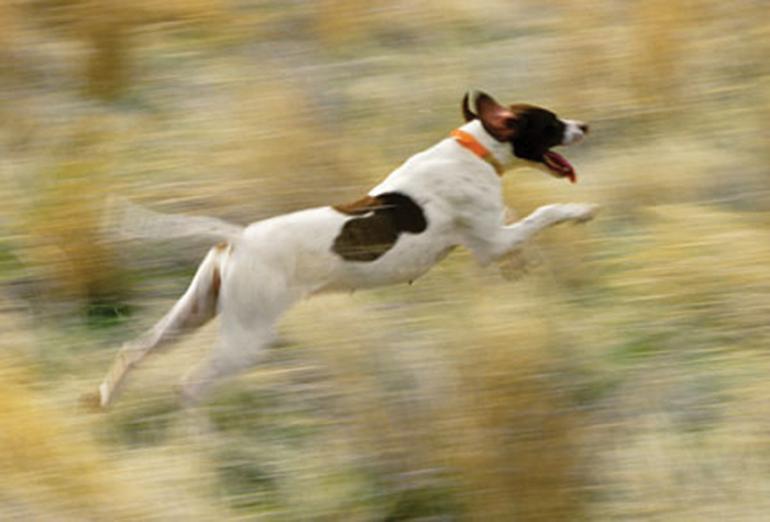Release the Hounds
Snare & trap tips.
Every year, Montana Fish, Wildlife & Parks receives a number of requests to hold workshops on releasing pets from traps. Many hikers, snowshoers, and cross-country skiers are concerned about their canine companions getting caught, and even though reports of accidental capture are rare, it’s important for these outdoor enthusiasts to feel comfortable giving Bridger a romp in the woods. Here are the key takeaways from these workshops.
The Basics
There are strict regulations for trapping in Montana, and trappers are required to have a license in order to trap furbearers and wolves. Traps can be set legally on both public and private land (with permission) and regulations differ for public and private land (ask a landowner if he or she allows trapping before venturing out on that land). There are designated high-use recreational trails in the Bozeman and Livingston area where traps have to be at least 500 feet away the trail. (See below.)
Trapping in Montana generally occurs in winter, but it’s a good idea to learn about protocol before the season is upon us. Upcoming season dates for furbearers and wolves are as follows:
Beaver, mink, muskrat, otter: Nov. 1, 2015 – Apr. 15, 2016
Bobcat: Dec. 1, 2015 – Feb. 15, 2016
Marten, wolverine: Dec. 1, 2015 – Feb. 15, 2016
Wolf: Dec. 15, 2015 – Feb. 28, 2016
Avoiding Traps
The best way to mitigate the risk to your pet is to avoid traps altogether. Here are some tips for doing just that.
1. Know how to spot traps. Look for unnatural signs of human activity such as sticks at 90-degree angles, feathers or glittery objects hanging from trees, and traps in the water or at the bottom of trees.
2. Avoid likely trapping areas. Keep dogs leashed around water and beaver dams, and any place that has been posted by trappers.
3. Pay attention to your dog, especially if it strikes a scent or is particularly curious about something.
4. Use established recreation areas. Higher-traffic areas are less likely to be used by trappers.
5. Be cautious if you see human tracks departing from trails. A lone set of tracks going off-trail might have been left by a trapper, so avoid following them.
If Your Dog Gets Trapped
Very few pets are caught in traps, and most are released unharmed. But some traps can be fatal. To remove your dog as quickly as possible, be in close contact and have voice control. A snare will tighten around your dog’s neck if not tended to quickly. Therefore, you need to calm your dog, and release or cut the snare with a pair of cable cutters. Test your pair on some cable while at home to make sure it can cut through a 3/32-inch cable. Buy a piece at the hardware store and practice.
Most cases of accidental trapping involve the most common type of trap—a foothold set. In order to release a foothold, apply pressure to one or two springs to open the jaws. You can use your hands or feet, but we suggest throwing a coat over your dog’s head to calm it before attempting the release. View a helpful video demonstrating trap and snare release at fwp.mt.gov/hunting/trapping.
Trapping has been part of Montana’s culture since the time of Lewis and Clark. Most trappers avoid high-use areas and set their traps responsibly. Remember that it is illegal to destroy, disturb, or remove trapped wildlife belonging to a trapper without permission of the owner of the trap or snare.
Step Back
While trapping and snaring are legal with the necessary permits, these heavily-used trails require traps to be set 500 feet back.—FWP
Hyalite Area
Lick Creek/Wildhorse trail #452
History Rock loops trail #424
Blackmore loops trail #423
Crescent Lake trail #213
West Shore trail #431
E. Fork Road/Palisade trail #433
Grotto Falls trail #432
Moser/Buckskin Road Loop
Maxy Loop trail #62
Bozeman Face Trails
Bozeman Creek/Moser winter trail #850 & 851
South Cottonwood winter trail #852
Bear Canyon winter trail #848
West Bridgers
"M" trails #538, #511, #512, & #513 in Sec 27 T1S, R6E
Sypes trial #531
Middle Cottonwood trail #586
Truman Gulch trail #535
Gallatin Canyon
Porcupine trail #34
Beehive Basin winter trail #861
Paradise Valley
Mill Creek trail #945
Suce Creek trail #44
Andrea Jones is the FWP Region 3 information and education program manager.










